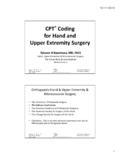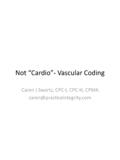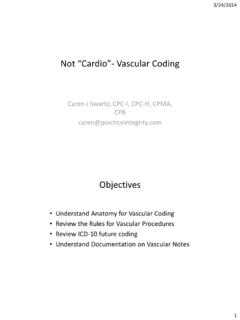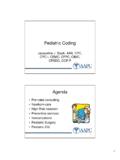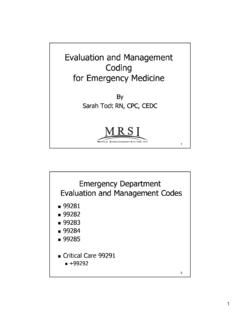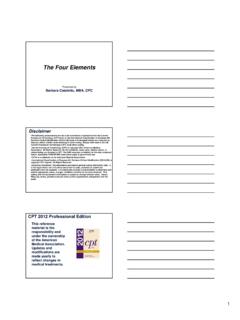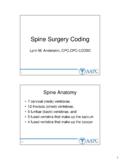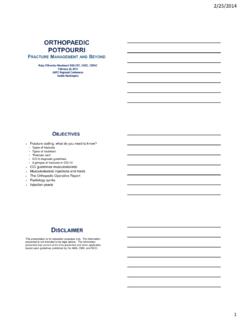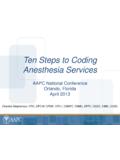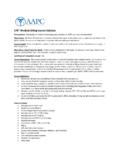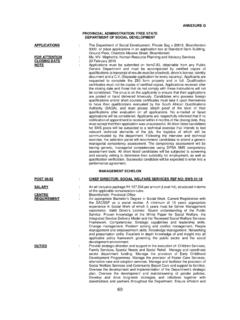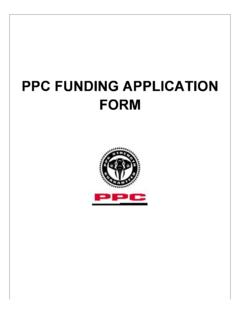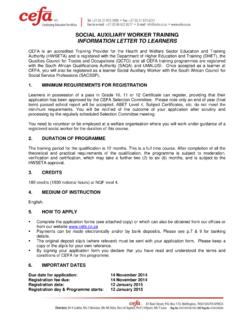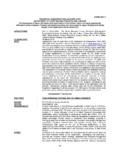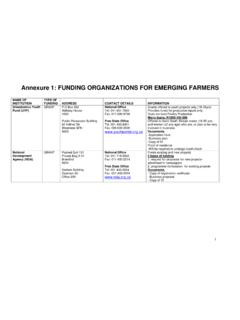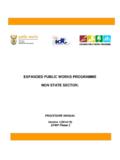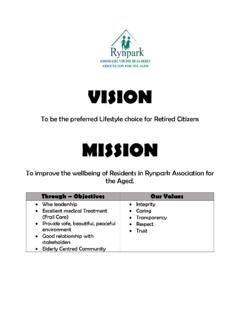Transcription of Specialty Code Set Training Gastroenterology - AAPC
1 ICD-10-CMSpecialty code Set TrainingGastroenterology2014 Module 3ii ICD-10-CM Specialty code Set Training Gastroenterology 2013 AAPC. All rights course was current at the time it was published. This course was prepared as a tool to assist the participant in understanding how to prepare for ICD-10-CM. Although every reasonable effort has been made to assure the accuracy of the information within these pages, the ultimate responsibility of the use of this information lies with the student. AAPC does not accept responsibility or liability with regard to errors, omissions, misuse, and misinterpretation. AAPC employees, agents, and staff make no representation, warranty, or guarantee that this compilation of information is error-free and will bear no responsibility, or liability for the results or consequences of the use of this does not accept responsibility or liability for any adverse outcome from using this study program for any reason including undetected inaccuracy, opinion, and analysis that might prove erroneous or amended, or the coder s misunderstanding or misapplication of topics.
2 Application of the information in this text does not imply or guarantee claims payment. Inquiries of your local carrier(s) bulletins, policy announcements, etc., should be made to resolve local billing requirements. Payers interpretations may vary from those in this program. Finally, the law, applicable regulations, payers instructions, interpretations, enforcement, etc., may change at any time in any particular manual may not be copied, reproduced, dismantled, quoted, or presented without the expressed written approval of the AAPC and the sources contained within. No part of this publication covered by the copyright herein may be reproduced, stored in a retrieval system or transmitted in any form or by any means (graphically, electronically, or mechanically, including photocopying, recording, or taping) without the expressed written permission from AAPC and the sources contained Examples Used in this BookAAPC believes it is important in Training and testing to reflect as accurate a coding setting as possible to students and examinees.
3 All examples and case studies used in our study guides and exams are actual, redacted office visit and procedure notes donated by AAPC preserve the real world quality of these notes for educational purposes, we have not re-written or edited the notes to the stringent grammatical or stylistic standards found in the text of our products. Some minor changes have been made for clarity or to correct spelling errors originally in the notes, but essentially they are as one would find them in a coding setting. 2013 AAPC2480 South 3850 West, Suite B, Salt Lake City, Utah 84120800-626- code (2633), Fax 801-236-2258, 081613. All rights , CPC-H , CPC-P , CPMA , CPCO , and CPPM are trademarks of AAPC. 2013 AAPC. All rights reserved. iii081613 ICD-10 ExpertsRhonda Buckholtz, CPC, CPMA, CPC-I, CGSC, CPEDC, CENTC, COBGC VP, ICD-10 Training and EducationShelly Cronin, CPC, CPMA, CPC-I, CANPC, CGSC, CGIC, CPPM Director, ICD-10 TrainingBetty Hovey, CPC, CPMA, CPC-I, CPC-H, CPB, CPCD Director, ICD-10 Development and TrainingJackie Stack, CPC, CPB, CPC-I, CEMC, CFPC, CIMC, CPEDC Director, ICD-10 Development and Training Peggy Stilley, CPC, CPB, CPMA, CPC-I, COBGC Director, ICD-10 Development and TrainingContentsCoding Cases.
4 31 2013 AAPC. All rights reserved. 31081613 Coding CasesCase 1 The patient is a 34-year-old patient who comes in today for evaluation of abdominal pain. She has acid reflux and sometimes cannot get out of bed as she is tired and nauseous. This occurs every few months, last occurrence was in October. She has been on Protonix for 6 months and was changed to Nexium last week. She has had a barium swallow 3 months : Chief complaint: Patient presents for evaluation of GERD and evaluation of possible hiatal : GERD and hiatal hernia. Present for years. Onset was gradual. Rated as moderate. Interferes with activities of daily life. Aggravated by eating. Symptoms not alleviated by anything. Has had an upper GI series within the last 3 months. Reports associated heartburn and indigestion, but denies associated dysphagia, flatulence, globu, hoarseness, recurrent pneumonia, sleeping difficulty and shortness of :Const: Denies anorexia, change in appetite, chills, fatigue, fever, and weight : Denies discharge from the ears and ear pain.
5 Denies rhinorrhea. Denies hoarseness, voice change, and sore : Denies arrhythmia, chest pain, and : Denies cough, dyspnea, sputum production, and recent : Denies symptoms other than stated : Urinary: Denies dysuria, frequency, and : Denies limitations of : Denies skin changes, pruritis, and : Denies discharge, lumps, masses, pain, and : Denies dizziness, lightheadedness, and : Denies intolerance to cold, intolerance to heat, night sweats, polyuria, excessive thirst, and excessive : Denies easy bleeding, easy bruising, and Meds: Nexium, Allegra-D 24 Hour, Advair DiskusAllergies: NKDA32 ICD-10-CM Specialty code Set Training Gastroenterology 2013 AAPC. All rights CasesPMH: Surgeries: CholecystectomyFH: Asthma, Cancer, Hypertension, DiabetesSH: Married. Does not smoke cigarettes. Denies alcohol use daily. Does not consume :Wt: 140; BP 117/77; Ht: 5 3 Exam:Const: Appears healthy and well developed.
6 No signs of acute distress present. Speech is clear and appropriate. Alert and : Atraumatic on : EOMI in both eyes. Sclerae are : Oral mucosa: Pink and moist with no : Supple. Palpation reveals no adenopathy No masses appreciated. Thyroid exhibits no : Lungs are clear : S1 is normal. S2 is normal. No heart murmur : Positive bowel sounds in all quadrants; abdomen is soft, nontender, and nondistended without guarding, rigidity or rebound tenderness; no abdominal masses; no palpable hernias; no palpable : No palpable or visible regional : Skin is warm and : Alert and oriented x3. No focal sensory or motor deficits : Gastroesophageal refluxPlan: Based on her history and symptoms, I advised evaluation of her upper GI tract with EGD. I explained the procedure to her in detail including risks, benefits, and alternatives. Informed consent was obtained. We will schedule the procedure.
7 ICD-10-CM code (s): _____ 2013 AAPC. All rights reserved. 33081613 Coding CasesCase 2 Preoperative Diagnosis: GI bleedingPostoperative Diagnosis: GastritisProcedure: Colonoscopy and gastroscopyDetails of Procedure: The colonoscope was placed in the rectal ampulla and advanced under visual guidance. There was fairly good preparation as we reached the ileocolonic anastomosis. Right on the ileocolonic anastomosis, there were some inflammatory changes, secondary to what appeared to be suture material. There were no ulcerations or suspicious looking lesions. The ascending, transverse, descending colons were normal. This sigmoid showed diverticular disease and inflammatory hemorrhoids. The colonoscope was then withdrawn. The patient was then repositioned and the gastroscope was then placed in the esophagus. The Z-line was at about 38. There was a small benign Schatzki s ring with some mild inflammation.
8 Not really big enough to dilate and the patient has continued his Plavix and therefore, it wasn t. Upon entering the stomach and cardia, there were a small polyps and some chronic gastritis, possibly H. pylori, vs. nonsteroidal-induced, but biopsies were taken for CLOE testing and a polyp was removed. Duodenum also showed some Inflammation and again, biopsy was taken for CLOE testing. There were no large ulcerations. No blood and the endoscope were removed and the patient tolerated the procedure : Status post resection of a large cecal polyp. No evidence of recurrence. Otherwise, a normal colonoscopy. Small Schatzki s ring. Chronic gastroduodenitis, possibly H. pylori, vs. nonsteroidal : The patient will continue on a proton pump inhibitor, if H. pylori testing are positive, we will treat accordingly. Follow-up colonoscopy and gastroscopy in three code (s): _____Case 3 Preoperative Diagnosis: Gallstone pancreatitis with gallbladder sludgePostoperative Diagnosis: Gallstone pancreatitis with gallbladder sludgeProcedure: Laparoscopic cholecystectomyOperative findings: The patient had what appeared to be mild chronic cholecystitis, otherwise : The patient was taken to the operative room, placed In supine position, prepped and draped in normal sterile fashion.
9 Once anesthesia was obtained, a supraumbilical midline incision was made, taken down to the fascia and via the Hasson technique, a port was placed. Under visualization, 3 other ports were placed, a xiphoid and 2 right upper quadrant ports. The xiphoid port was 10 mm; the 2 others were 5 mm. Once we were in the abdomen, the liver was retracted upward, the gallbladder was visualized and dissection of the cystic duct and cystic artery were easily obtained. Once we had good dissection, we had a good critical view; we clipped and ligated the cystic artery and cystic duct. Once these were cut, we dissected the gallbladder off the fossa 34 ICD-10-CM Specialty code Set Training Gastroenterology 2013 AAPC. All rights Casesfrom a bottom to top direction. The gallbladder was removed, placed in the Endobag, and then the gallbladder fossa was irrigated and cauterized to obtain good hemostasis.
10 We irrigated multiple times and obtained good hemostasis. We then removed the visualization, removed the 5 mm ports. Then we were able to remove the gallbladder from the abdomen and closed the supraumbilical port with 3 Vicryl sutures. We then closed the skin with subcuticular Vicryl sutures and placed a sterile dressing. The patient tolerated the procedure well. ICD-10-CM code (s): _____Case 4 History of Present Illness: The patient is a 45-year-old male who reports that he was fine until yesterday when he ate a bowl of fruit with onset suddenly afterwards of abdominal pain. It was mid abdomen, sharp in nature. He reports he took some Citrucel and hoped that this would alleviate the symptoms. He actually went golfing and after finishing nine holes, he reports the pain was severe. He could not continue and he then subsequently presented to the emergency department. En route, he has an episode of nausea and emesis.
